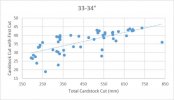I forgot that I asked you to send me the data, I created this chart from it:
I ran 1-way ANOVA for all the groups as well as T-tests comparing just 34' at 0.010" to 0.020" and comparing 50' at 0.010" to 0.020". The P-value
was not significant for the 34' blades (which, it so happens, are the ones where each card-cut is completed within the edge-bevel).
In an M390 blade? I get grindability from the manufacturer stand-point - makes it easier/cheaper, but noticeably vs a couple points higher? It won't affect sharpening for the end-user. Higher toughness? Again, hard to believe. While edge-retention isn't the "only" desirable attribute in knives, I would frankly require evidence from someone that the lower-hardness result gives any advantage to anyone at all other than competitors.

I told you what I mean multiple times. My apologies, I will try again below.
I added emphasis here, and thank you for that. I added the emphasis because of the comparison to other sharpness testing I have seen measuring the force required to complete a cut rather than measuring the amount of cutting achieved with a set maximum force, my brain-fart. Watching the video linked in your link

is helpful too, seeing the card-stack ride up the blade-edge during the stroke with only 50N applied downward force

If cutting nothing at the end, 50N is insufficient force to complete a cut... really a 'mash' at that point!
"Sharpness" = mechanical advantage, i.e. the ease (or lack of force/effort) with which a cut is completed. CATRA, rather than measuring the force required to complete a cut measures the amount of media cut on a given stroke at a given force. While it is difficult to determine "sharpness" from data that does not measure force, the ratio of media cut in the first stroke to the next or the third shows the loss of "sharpness" i.e. edge-retention represented in the bottom-right quadrant of my image above. While the edge is theoretically at "relative 100%" sharpness BEFORE the first cut, we can't measure force OR amount of media cut at a given force before making a first cut

However, if edges are sharpened identically, we might infer identical "100%" sharpness levels in advance of the cut. Anyway, performance is down to <80% and in some of the cases <40% of the first-cut level by the end of the 3rd cut.
In your image below, from the link provided, by the 4th or 5th cut the exponential decline in performance begins to level out. By the 10th cut in the steel with lowest wear-resistance, the edge is performing at near 10% of where it was in the first cut. That is an example of what I am referring to in regard to the "working edge" being at only ~10% the initial sharpness/performance - doing 9x less work or requiring 9x the effort to do the same work. It is wonderful to see materials fighting this, however, providing us a sharper edge through more work




 If cutting nothing at the end, 50N is insufficient force to complete a cut... really a 'mash' at that point!
If cutting nothing at the end, 50N is insufficient force to complete a cut... really a 'mash' at that point!